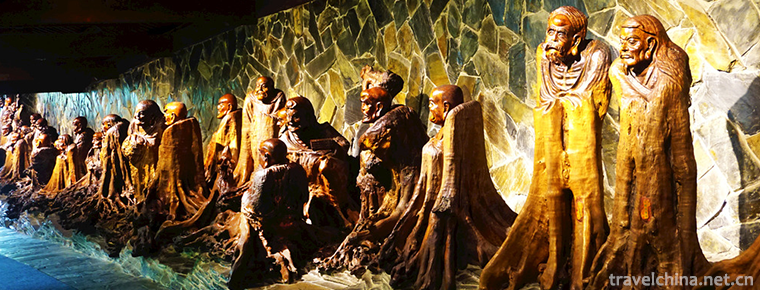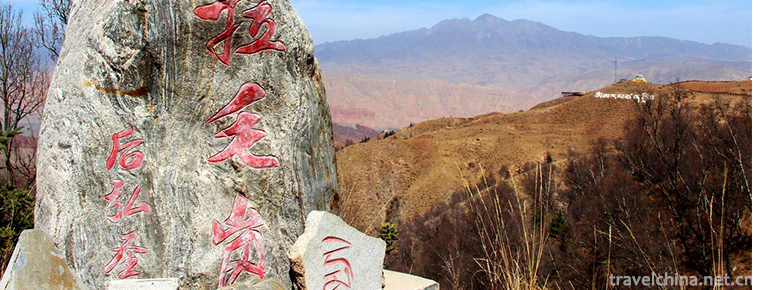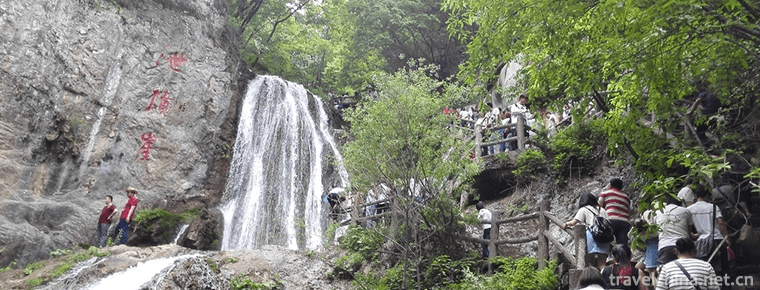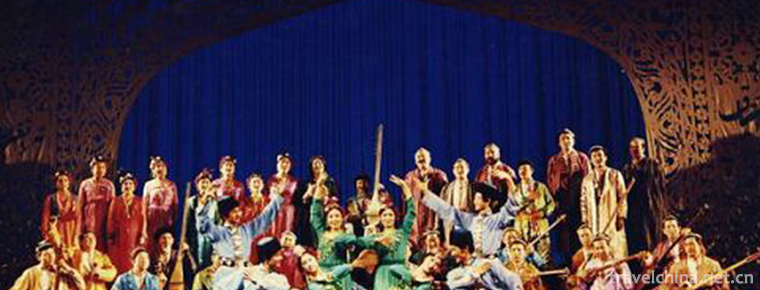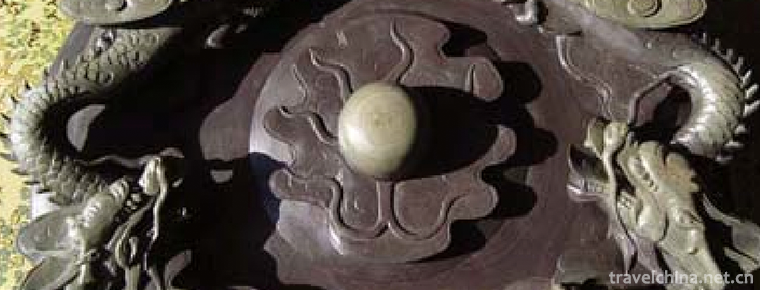Beijing silk flower
Beijing silk flower
Beijing silk flower, one of the traditional handicraft products in Beijing, also known as "Beijing flower", originated in Shenmuchang Street outside Chongwenmen in Ming Dynasty. It is a traditional art form made from silk, silk, satin and other raw materials through chisel, dyeing, gripping and accumulation.
Silk flower originated in Tang Dynasty and has a history of more than 1000 years. According to legend, there was a scar on the left sideburns of Empress Yang, the beloved concubine of Emperor Xuanzong Li Longji in Tang Dynasty. Every day, the palace girls were asked to pick flowers and wear them on the sideburns. But in winter, the flowers fade. A clever palace lady made false flowers out of ribs and silk for her princess. Later, this kind of "headdress flower" spread to the folk, prevailed for a time, and gradually developed into a unique style of handicraft "silk flower".
On June 7, 2008, Beijing silk flowers were listed in the second batch of national intangible cultural heritage list with the approval of the State Council.
Historical origin
Silk Flowers Made of Golden Bells
Beijing silk flower is famous both at home and abroad for its beautiful shape, exquisite workmanship, pleasant color, harmony, softness and vivid image.
According to the Qing Dynasty "Historical Relics of the Old Capital" records: "In Guangxu, there are people with the surname of Jin who make paper potted flowers and vases exquisitely, and people call them flowers and gold. So far, there is no right person with the surname of Jin in this industry." After several generations, the silk flower technique of Beijing was introduced into the Beijing Silk Flower Factory established in 1960 by the old artists such as Huaerjin and Huaerliu. Since then, the silk flower of Beijing has been sold well in more than 50 countries and regions in the world. In the largest Dutch flower market in the world, the silk flower of Beijing is juxtaposed with the fresh flowers and is in contention with each other. A basin of "10 Zhang Pearl Curtain" chrysanthemum produced by Jin Yulin, the fourth generation heir of "Huaer Jin", won the gold and silver prizes in the national arts and crafts hundred flower award industry evaluation. However, with the closure of Beijing Silk Flower Factory, only a few people have mastered silk flower skills, and the inheritance is facing a crisis. At that time, silk flower factories were mainly planned economy. Because of insufficient research on foreign markets and lack of grasp of changes in the international market, silk flower suddenly became unsalable since the 1990s.
The silk flowers made by famous artists in Beijing have won prizes at Panama World Expo. Nowadays, varieties have developed from dozens to more than 2000, including drama flowers, flower fibers, flower baskets, bonsai and so on. The production process of silk flower is: material selection, sizing, dyeing, pit petal, drying, setting, sticking, branching and other processes.
Silk flower culture
Beijing silk flower is made of high-grade pure silk, which can be divided into two categories: silk branch flower and silk potted flower.
Silk flower making
There are more than 8000 varieties. The pattern of silk branch varies from one type to another. The peony of the king of flowers is as beautiful as smoke; the rose of the queen in flowers is charming and beautiful; the autumn chrysanthemum with pride frost and fragrance is elegant and elegant; the Rhododendron in full bloom brings people into the mood of "a pile of spring smoke covered with red snow".
Silk flower, also known as "Jinghua Er", has a long history. According to legend, there is a scar on the left temple corner of Empress Yang, the favorite concubine of Emperor Xuanzong Li Longji in Tang Dynasty. Every day, the palace girls pick flowers and wear them on the temple corner. But in winter, the flowers fade. A clever palace lady made false flowers out of ribs and silk for her princess. Later, this kind of "headdress flower" spread to the folk, prevailed for a time, and gradually developed into a unique style of handicraft "silk flower". The picture of hairpin flowers and ladies by Zhou Fang, a famous painter in Tang Dynasty, vividly depicts the scene of women wearing flowers at that time. The silk flowers in Beijing began in the Ming Dynasty. By the Qing Dynasty, silk flowers were more prevalent. There were various workshops set up by the Imperial Palace in the Qing Dynasty, specializing in producing various kinds of flowers for banquets and decorations, such as silk, silk, paper, grass and rice. Liu Hengyuan, a famous folk artist in the Qing Dynasty, made the silk flower "Huaer Liu", which won an award at Panama World Expo.
The Waihua Street in Chongwenmen, Beijing, was the gathering place for the production and sale of "Jinghua'er" at that time. More than 100 years ago, there were numerous flower-making workshops and famous flower-making teachers gathered here. "Yan Jing Sui Shi Ji" contains: "From the first month of Chongwenmen to the east, there are markets on the fourth, fourteenth and twenty-fourth day of junior high school. The so-called flower market is a paper flower put on by women, which is also a flower from time to time. Flowers can be mixed up with grass, silk, twigs and wrestling. In the month of Mengchun in Beijing, children cut colorful flowers or insects and so on. They clamoured day by day, that is, the so-called "costume" in ancient times is also the origin of silk flowers.
Inheritance significance
In 2007, Beijing silk flower was listed in the second batch of Beijing intangible cultural heritage list. In 2008, Beijing silk flowers were selected into the Second National List of intangible cultural heritage with the approval of the State Council. In 2009, Jintieling was named the representative successor of national non-heritage projects. In 2010, Xu Wenjing was named the representative successor of district-level non-heritage projects.



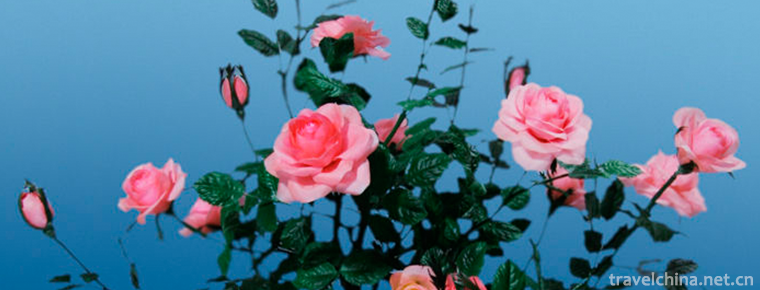
-
Old Summer PalaceYuanmingyuan
No. 28 Qinghua West Road, Haidian District, Beijing, China.
Views: 115 Time 2018-10-03 -
Shanghai Wild Animal Park
Shanghai Wild Animal Park , located at 178 Nanliu Highway, Pudong New Area, Shanghai, is the first National Wildlife Park in China built by the Shanghai Municipal People's Government and the State For.
Views: 164 Time 2018-12-05 -
Root palace Buddhist Cultural Tourism Zone
Root palace Buddhist Cultural Tourism Zone / Gengong Buddha Country Cultural Tourist Area, National AAAAA Tourist Scenic Area, National Eco-civilization Education Base.
Views: 125 Time 2018-12-07 -
Yellow River Grand Canyon
The Yellow River Grand Canyon is located in Qingtongxia Town, Wuzhong City, Ningxia. It is 20 kilometers away from Wuzhong City. It is a scenic spot of the Yellow River Canyon composed .
Views: 159 Time 2019-01-18 -
Chongdugou Scenic Area
Zhongdugou Scenic Area, located in Luanchuan County, Luoyang City, Henan Province, was given the name of emperor because Liu Xiu, Emperor Guangwu of the Eastern Han Dynasty.
Views: 201 Time 2019-03-18 -
Firing Techniques of Fengxi Porcelain
Fengxi Porcelain Firing Technology, a local traditional technology in Fengxi District, Chaozhou City, Guangdong Province, is one of the national intangible cultural heritage..
Views: 771 Time 2019-04-29 -
Qingxu Caimen Building
Qingxu Caimen Tower is a local traditional handicraft in Qingxu County, Shanxi Province. Xu Caimen Tower in Qing Dynasty is said to have originated in Tang Dynasty. During the festival, people gathere.
Views: 144 Time 2019-06-11 -
Uygur Daolang Maxi Refu
Maigaiti County is located in the southwest of Xinjiang Uygur Autonomous Region. It is a typical Uygur inhabited area. About 89% of the population is Daolang Uygur who can sing and dance well. Among t.
Views: 147 Time 2019-06-26 -
Inkstone Platform Making Skills
Inkstone production skills, Liaoning Province Benxi City, Ningxia Hui Autonomous Region Yinchuan City, Hebei Province Yi County, Shanxi Province Xinjiang County, Gansu Province Zhuoni County, Min Coun.
Views: 88 Time 2019-07-10 -
Social undertakings in Luzhou
As of the end of 2018, Luzhou has added 1 provincial key laboratory, 1 provincial engineering technology research center, 4 incubators of science and technology enterprises above the provincial level, and 16 national high-tech enterprises. The annual output value of high-tech reached 38.
Views: 351 Time 2020-12-14 -
Sports in Luzhou
By the end of 2017, there were 1654 fitness facilities and venues in Luzhou City, and 1.093 million person times of physical exercise were opened free of charge in the whole year. Six municipal level competitions including track and field, football (spring League), badminton.
Views: 382 Time 2020-12-14 -
Resources and environment of Leshan
By the end of 2018, the total energy consumption of Leshan City was 15.3994 million tons of standard coal, an increase of 580900 tons of standard coal over the previous year. The energy consumption of 10000 yuan GDP decreased by 4.38%..
Views: 144 Time 2020-12-17


